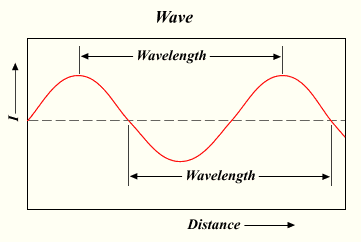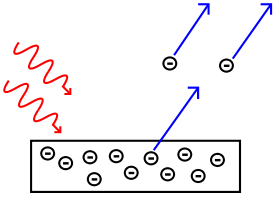General Chemistry/Introduction to Quantum Theory
< General ChemistryIntroduction to Quantum Mechanics
In the late 19th century, many physicists believed that they had made great progress in physics, and there wasn't much more that needed to be discovered. The classical physics at the time was widely accepted in the scientific community. However, by the early 20th century, physicists discovered that the laws of classical mechanics break down in the atomic world, and experiments such as the photoelectric effect completely contradict the laws of classical physics. As a result of these crises, physicists began to construct new laws of physics which would apply to the atomic world; these theories would be collectively known as quantum mechanics. Quantum mechanics, in some ways, completely changed the way physicists view the universe, and it also marked the end of the idea of a clockwork universe (the idea that the universe was predictable).
Electromagnetic Radiation
Electromagnetic radiation (ER) is a form of energy that sometimes acts like a wave, and other times acts like a particle. Visible light is a well-known example. All forms of ER have two inversely proportional properties: wavelength and frequency. Wavelength is the distance from one wave peak to the next, which can be measured in meters. Frequency is the number of wave peaks observed in a given point during a second. The unit for frequency is hertz.

Since wavelength and frequency are inversely related, their product (multiplication) always equals a constant — specifically, 3.0 x 108 m/sec, which is better known as the speed of light.
The wavelength and frequency of any specific occurrence of ER determine its position on the electromagnetic spectrum.

As you can see, visible light is only a tiny fraction of the spectrum.
The energy of a single particle of an electromagnetic wave (called a photon) is given by , where is Plank's constant and is the frequency. Energy is directly proportional to frequency — doubling the frequency will double the energy.
The Discovery of the Quantum

So far we have only discussed the wave characteristics of energy. However, the wave model cannot account for something known as the photoelectric effect. This effect is observed when light focused on certain metals apparently causes electrons to be emitted. (Photoelectric or solar panels work on this principle.)
For each metal it was found that there is a minimum threshold frequency of electromagnetic radiation that is needed to be shone on it in order for it to emit electrons. One could not replace a certain amount of light at one frequency with twice as much light of half the frequency. If light only acts as a wave, the effect of light should be cumulative - the light should add up, little by little, until it causes electrons to be emitted. Instead, there is a clear-cut minimum of the frequency of light that triggers the electron emissions.
The implication of this is that frequency is directly linked to energy, the higher light frequencies having more energy. This observation led to the discovery of the minimum amount of energy that could be gained or lost by an atom. Max Planck named this minimum amount the quantum, plural "quanta", meaning "how much". One photon of light carries exactly one quantum of energy.
More Evidence for a Particle Theory of Energy
When an electric current is passed through a gas, some of the gas molecules' electrons move from their ground state to an excited state that is further away from their nuclei. When the electrons return to the ground state, they emit energy of various wavelengths. A prism can be used to separate the wavelengths, making them easy to identify.
If light acted only as a wave, then there should have been a continuous rainbow created by the prism. Instead, there were discrete lines created by different wavelengths. This is because electrons release specific wavelengths of light when moving from an excited state to a ground state.